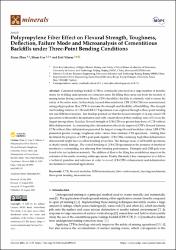| dc.contributor.author | Zhao, Ziyue | |
| dc.contributor.author | Cao, Shuai | |
| dc.contributor.author | Yılmaz, Erol | |
| dc.date.accessioned | 2023-10-31T08:23:42Z | |
| dc.date.available | 2023-10-31T08:23:42Z | |
| dc.date.issued | 2023 | en_US |
| dc.identifier.citation | Zhao, Z., Cao, S. & Yılmaz, E. (2023). Polypropylene Fiber Effect on Flexural Strength, Toughness, Deflection, Failure Mode and Microanalysis of Cementitious Backfills under Three-Point Bending Conditions. Minerals, 13(9), 1135. https://doi.org/10.3390/min13091135 | en_US |
| dc.identifier.issn | 2075-163X | |
| dc.identifier.uri | https://doi.org/10.3390/min13091135 | |
| dc.identifier.uri | https://hdl.handle.net/11436/8611 | |
| dc.description.abstract | Cemented tailings backfill (CTB) is continually practiced in a large number of metallic mines for re-filling underground ore extraction areas. Re-filling these areas can boost the security of mining teams during construction. Hence, CTB’s durability/ductility is extremely vital to ensure the safety of the entire mine. In this study, layered-fiber-reinforced CTB (LFR-CTB) was manufactured using polypropylene fiber (PPF) to increase the strength and flexibility of backfilling. The strength and bending features of CTB and LFR-CTB specimens were explored through a three-point bending test and SEM microanalysis. Test findings pointed out that the flexural strength of 14-day-cured CTB specimens without fiber delamination and with cement showed that a tailings ratio of 1:4 was the largest among others. Residual flexural strength of LFR-CTB was greater than those of CTB without fiber delamination. Accumulating fiber delamination effectively improved CTB’s flexural features. CTBs without fiber delamination presented the largest average flexural modulus values. LFR-CTBs presented greater average toughness index values than ordinary CTB specimens. Adding fiber facilitated the progress of CTB’s post-peak rigidity. LFR-CTBs containing high-fiber delamination dimensional height have excellent bending properties. The damage mode of all backfill specimens is chiefly tensile damage. The overall bonding of LFR-CTB specimens in the presence of interlayer interfaces is outstanding, not affecting their bending performance. Ettringite and CSH gels were found to be key hydration materials. The addition of fiber to the filling has an inhibitory impact on the extension of the cracks occurring within specimens. Finally, this study’s key consequence is to deliver a technical guideline and reference in order to reveal LFR-CTB’s enhancement and delamination mechanism for industrial applications. | en_US |
| dc.language.iso | eng | en_US |
| dc.publisher | MDPI | en_US |
| dc.rights | info:eu-repo/semantics/openAccess | en_US |
| dc.subject | CTB | en_US |
| dc.subject | Flexural modulus | en_US |
| dc.subject | SEM microanalysis | en_US |
| dc.subject | Fiber reinforcement | en_US |
| dc.subject | Layering mechanism | en_US |
| dc.subject | Three-point bending | en_US |
| dc.subject | Microstructure | en_US |
| dc.title | Polypropylene fiber effect on flexural strength, toughness, deflection, failure mode and microanalysis of cementitious backfills under three-point bending conditions | en_US |
| dc.type | article | en_US |
| dc.contributor.department | RTEÜ, Mühendislik ve Mimarlık Fakültesi, İnşaat Mühendisliği Bölümü | en_US |
| dc.contributor.institutionauthor | Yılmaz, Erol | |
| dc.identifier.doi | 10.3390/min13091135 | en_US |
| dc.identifier.volume | 13 | en_US |
| dc.identifier.issue | 9 | en_US |
| dc.identifier.startpage | 1135 | en_US |
| dc.relation.journal | Minerals | en_US |
| dc.relation.publicationcategory | Makale - Uluslararası Hakemli Dergi - Kurum Öğretim Elemanı | en_US |


















